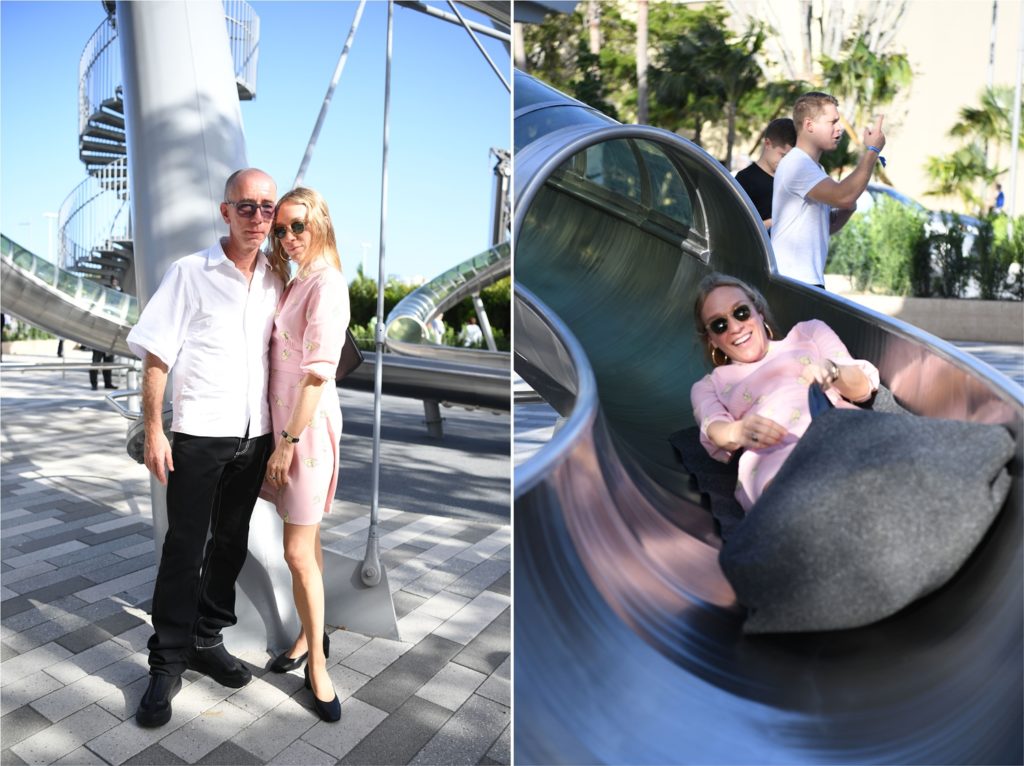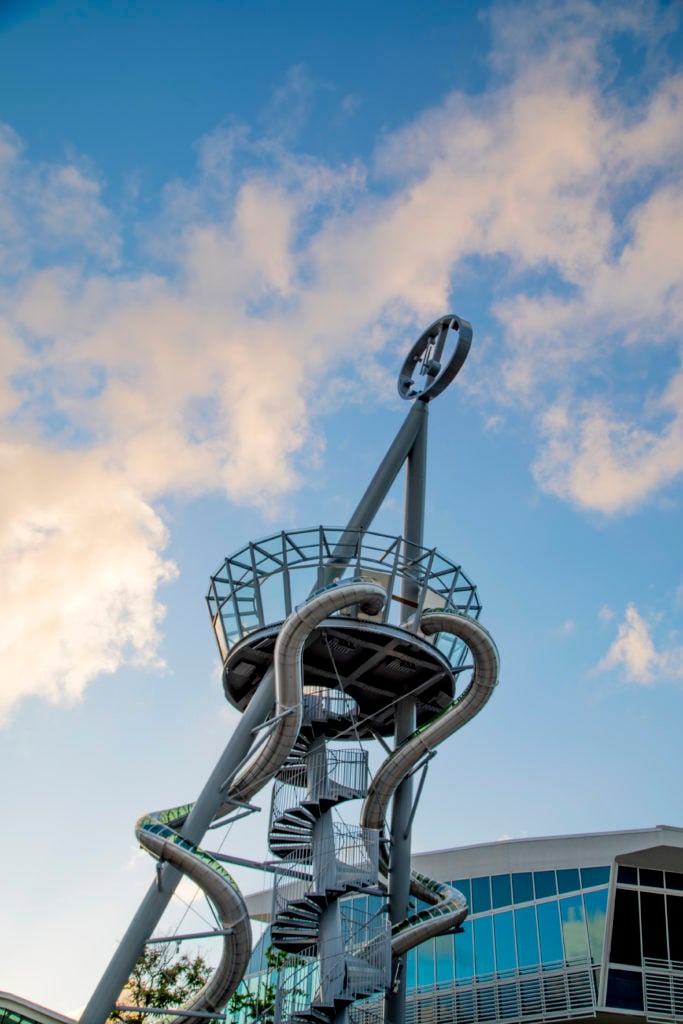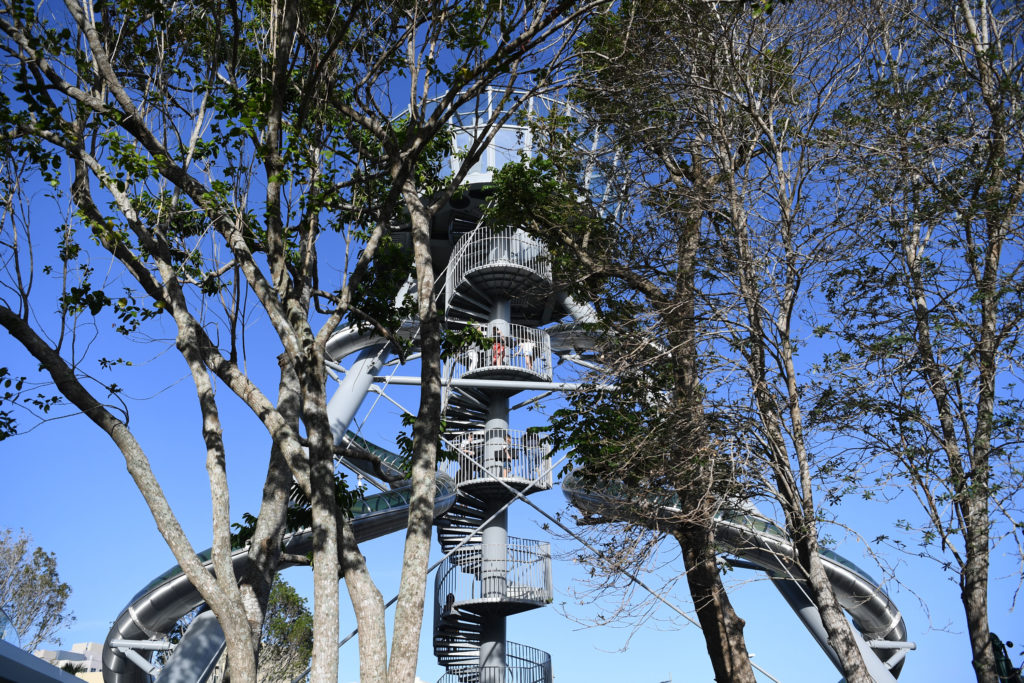On View
Artist Carsten Höller Brings a Massive Slide to a Miami Shopping Mall—With a Little Help From Chloë Sevigny
Can Instagram-friendly contemporary art help the Aventura Mall succeed in an increasingly challenging retail landscape?

Can Instagram-friendly contemporary art help the Aventura Mall succeed in an increasingly challenging retail landscape?

Allie Biswas

Earlier this week at a luxury shopping mall in a suburb of Miami, passersby heard an unlikely sound coming from high overhead: a disembodied, high-pitched scream. A few seconds later, the actress Chloë Sevigny emerged at ground level from a sizeable steel cavity.
Sevigny was in Miami to officially inaugurate the Belgian-German artist Carsten Höller’s first permanent slide in the United States. The slide—one of Höller’s largest to date—is a site-specific commission by the Aventura Mall, a high-end shopping center that also purchases and presents contemporary art.
After her maiden voyage on the slide, Sevigny and Höller, who are longtime friends, climbed the 93-foot-tall tower together to travel in tandem down the double-barreled structure.

Carsten Höller and Chloë Stevens Sevigny; Sevigny descending the Slide Tower.
Höller’s installation rises high above an outdoor courtyard and welcomes visitors to the mall’s new three-level expansion, which opened its first phase late last year. The slide, titled Aventura Slide Tower, is one of 15 works in the mall’s growing collection—and its boldest statement yet.
The mall’s owners began building the collection in 2005, after some prodding from local collector and philanthropist Norman Braman. “He told me that Aventura is our town’s hub—we get over 28 million visitors a year—so it is our responsibility to bring culture to people,” Jackie Soffer, co-chairman and CEO of the real estate developer Turnberry Associates, which owns and manages the mall, told artnet News.
Since then, Soffer has sought to collect high-quality art with a special focus on interactive pieces that “provide experiences that some of our visitors would not otherwise have.” The project is also a canny way to attract audiences at a time when malls across the country are closing and the retail industry is fighting for survival amid the rise of online shopping.
Strolling through the second-largest retail space in the country, shoppers can now view Instagram-friendly sculptures and installations by artists including Louise Bourgeois, the Haas Brothers, Gary Hume, Julian Opie, Ugo Rondinone, and Lawrence Weiner. (The company declined to specify its annual acquisition budget or the cost of the Höller project.)

Carsten Höller’s Aventura Slide Tower. Courtesy of the artist.
Since Höller created his first slide in 1999, the works have attracted long lines at institutions ranging from the New Museum in New York to the Hayward Gallery in London. But the artist was particularly drawn to the prospect of creating a version for what he described as “an arty shopping mall,” where it could take on another dimension.
“I like artworks that are not necessarily only an artwork,” Höller told artnet News. “I like the idea of putting work into a context that is not a museum.” The artist created his first permanent slide for fashion designer Miuccia Prada’s office in 2000. The Aventura commission comprises two giant steel spirals that run in opposite directions. It is so large that riders can reach speeds of up to 15 miles per hour.
As with Höller’s other slide installations, creating a sense of joy is perhaps at the heart of his enterprise. “I want to use amusement as a force in our life,” he said.

The inauguration of Carsten Höller’s Aventura Slide Tower. Courtesy of the artist.
At a time when the line between contemporary art and entertainment has never been blurrier, the appetite for social media-friendly art has never been larger, and art fairs are increasingly criticized for turning collecting into a shopping experience, Aventura’s approach seems to be a logical step—even if some might complain it reduces art to window dressing.
For Höller, whether the mall’s visitors recognize what they are seeing as high-caliber art seems to be beside the point. As he pointed out, “In this context, it can go completely unrecognized as being an artwork. It can just be a slide tower.”